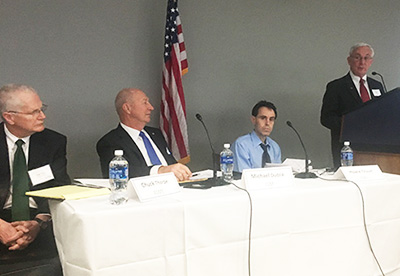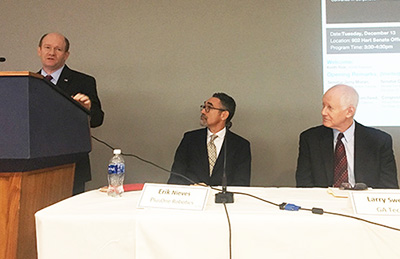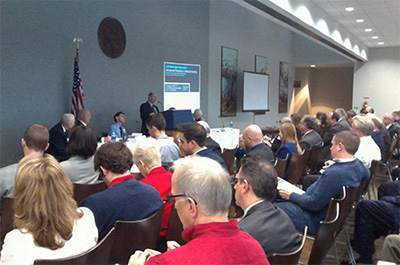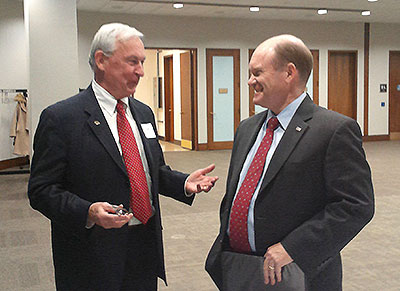Recent ASME Congressional Briefing Examines Robotics and Manufacturing
Recent ASME Congressional Briefing Examines Robotics and Manufacturing
Jan. 27, 2017

The ASME Government Relations department recently hosted a Congressional Briefing on advanced robotic technologies and their impact on manufacturing. The briefing, titled “Advanced Robotics in Manufacturing: Enabling New Technology and Increased Opportunity,” was held Dec. 13, 2016, at the Senate Hart Office Building in Washington, D.C.
The briefing featured a panel discussion highlighting four prominent members of the robotics and manufacturing research communities: Howie Choset, professor of robotics at Carnegie Mellon University and co-founder of Medrobotics Inc.; Larry Sweet, the IRIM Associate Director of Technology Transition and Professor of the Practice in Robotics at Georgia Institute of Technology; Erik Nieves, founder and CEO of PlusOne Robotics and a member of the ASME Robotics Public Policy Task Force; and Michael Dudzik, president of the scientific research institute IQM. The panel was moderated by Chuck Thorpe, senior vice president and provost of Clarkson University and co-chair of the ASME Robotics Public Policy Task Force.

Following an introduction by ASME President Keith Roe, the briefing began with opening remarks delivered by Senator Chris Coons (D-DE), co-chair of the Senate Competitiveness Caucus, who suggested a few topics for the panelists to consider during their discussion. These included what the manufacturing industry might look like in the future, what impact robotics could have on the manufacturing jobs market, and how small and medium-sized companies can best be helped to succeed with — and adapt to — new technologies. The senator added that he thought there was reason for optimism moving forward, citing the Manufacturing USA and Manufacturing Extension Partnerships (MEP) initiatives as opportunities for increased success in the coming year.
The briefing’s moderator, Chuck Thorpe, then set the stage, providing the audience with an overview of how robots are changing the manufacturing environment. Whereas we once thought of manufacturing as “dangerous,” “dull” and “disappearing,” there are now new “D-words” associated with the field, according to Thorpe. These include “dexterous,” because robots can access places and perform tasks that humans cannot or should not, and “deeply integrated,” since robotic technologies today are built into the systems themselves, so they don’t look like robots. Addressing whether manufacturing was disappearing, Thorpe doesn’t believe so. Instead, he said, new robotic technologies are encouraging new skills and jobs to arise. Thorpe ended with the idea that for further advancement, robotics needs mechanical engineering, and mechanical engineers need robotics, a connection that is often overlooked.

Howie Choset of Carnegie Mellon, the first panelist to present, spoke to the relationship between robotics and jobs. Choset has a background in working with “snake robots” — highly flexible systems designed to go into small spaces — and believes that flexibility, both in a robot’s structure and skill, is the key to advancing the industry. Robotic systems are expensive and 98.5 percent of manufacturers in the United States are small- or medium-sized manufacturers who do not have the capital to invest in technology that cannot adapt to future changes. Choset also mentioned that paired with this idea of flexible robots is the need for flexible job training.
The following panelist, Larry Sweet, agreed with Choset’s final point, and went on to speak about the increased need for collaborative robotics. Observing that many manufacturers see the opportunity to grow if automation becomes more flexible, Sweet noted that the key is to balance the risk of adopting new technologies while making systems more flexible for increased productivity. Collaborative robots, flexible robots, and mobile robots are all new types of technologies that will inject flexibility into the system, prompting innovation and increased productivity. Today, robots and humans are co-habiting manufacturing floors, but working separately. In order to advance, Sweet suggests that humans and robots must work together so that they can each perform the tasks the other cannot at the same time, on the same product.

Panelist Erik Nieves, an industrial robotics engineer, spoke further about the impact of robotics on the small manufacturer. Most manufacturing that employs robots today is low-mix, high-volume production, or manufacturing processes that build the same thing over and over. Robots are extremely good at repetitive tasks, but they need to become better at doing high-mix, low-volume production. Nieves noted that three-quarters of our industrial base is made up of companies of 20 employees or less, meaning the main place for growth in robotic manufacturing is with small companies.
The session’s final panelist, Michael Dudzik, also provided a voice for small companies. Noting that robots come to the manufacturing floor first and foremost because of a business need and not because of technology for technology’s sake, he added that adopting robotic technology needs to be a good return on investment for a small company that has limited capital to invest. Dudzik said this was the reason robots today need to be agile and flexible, and echoed the sentiments of the previous speakers who called for increased flexibility in both our robotic systems and our workers. Dudzik suggested that Congress could help advance robotics by implementing policies that help accelerate the robotics ecosystem in the United States so that the U.S. manufacturing base can be more competitive globally.
Samantha Fijacko, ASME Government Relations




